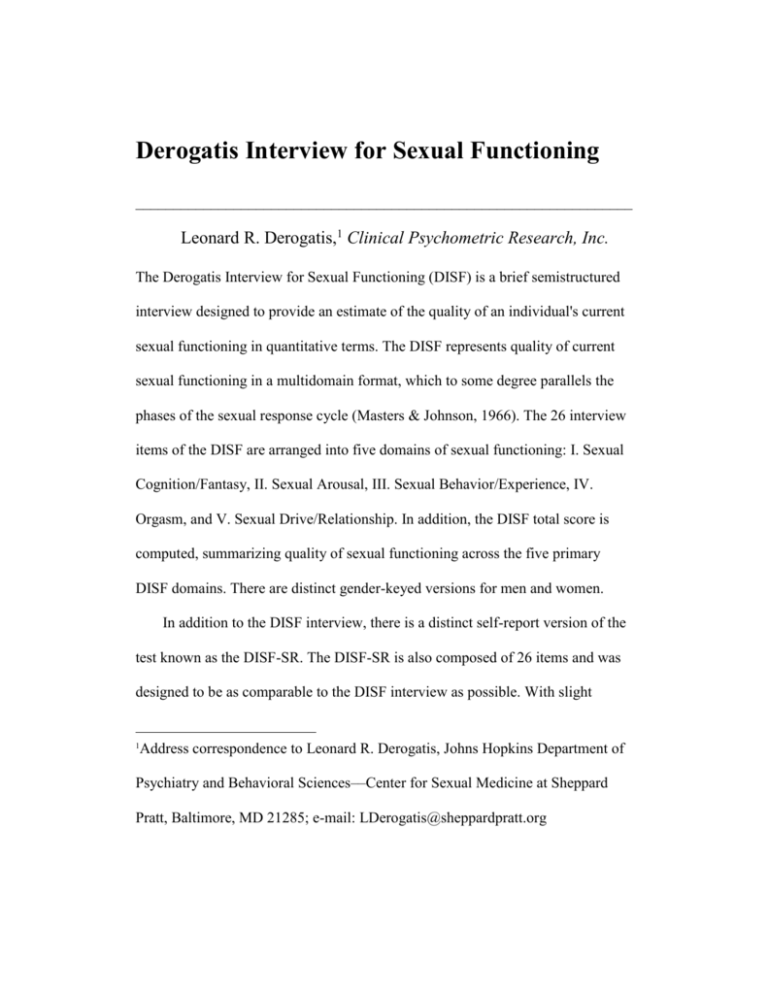
Derogatis Interview for Sexual Functioning
__________________________________________________________________
Leonard R. Derogatis,1 Clinical Psychometric Research, Inc.
The Derogatis Interview for Sexual Functioning (DISF) is a brief semistructured
interview designed to provide an estimate of the quality of an individual's current
sexual functioning in quantitative terms. The DISF represents quality of current
sexual functioning in a multidomain format, which to some degree parallels the
phases of the sexual response cycle (Masters & Johnson, 1966). The 26 interview
items of the DISF are arranged into five domains of sexual functioning: I. Sexual
Cognition/Fantasy, II. Sexual Arousal, III. Sexual Behavior/Experience, IV.
Orgasm, and V. Sexual Drive/Relationship. In addition, the DISF total score is
computed, summarizing quality of sexual functioning across the five primary
DISF domains. There are distinct gender-keyed versions for men and women.
In addition to the DISF interview, there is a distinct self-report version of the
test known as the DISF-SR. The DISF-SR is also composed of 26 items and was
designed to be as comparable to the DISF interview as possible. With slight
1
Address correspondence to Leonard R. Derogatis, Johns Hopkins Department of
Psychiatry and Behavioral Sciences––Center for Sexual Medicine at Sheppard
Pratt, Baltimore, MD 21285; e-mail: LDerogatis@sheppardpratt.org
modifications in format, the DISF-SR may also be utilized to gain evaluations of
the patient's sexual performance by the patient's spouse.
The DISF and DISF-SR were developed to address the unmet need for a set
of brief, gender-keyed, multidimensional outcome measures that would represent
the status of an individual's current sexual functioning, and do so at multiple
levels of interpretation. The DISF/DISF-SR are designed to be interpreted at three
distinct levels: the discrete item level (e.g., "A full erection upon awakening,"
"Your ability to have an orgasm," the functional domain level (e.g., sexual arousal
score), and the global summary level (e.g., DISF/DISF-SR total score). Because
the DISF interview and the DISF-SR self-report inventory are matched on an
almost item-for-item basis, clinician and patient assessments of the patient's
quality of sexual functioning may be obtained in both raw and standardized score
formats. Both instruments may be used repeatedly throughout efficacy or
effectiveness trials, or may be implemented solely at pre- and postintervention
without significant "practice" effects or loss of validity.
Norms have been developed for both the DISF and the DISF/SR, based in
each case on several hundred nonpatient community respondents. The norms are
gender-keyed (i.e., separate norms for men and women) and are represented as
standardized scores in terms of area t-scores. The area standardized score
possesses distinct advantages over the simple linear transformation in that the
former provides accurate percentile equivalents (i.e., t-score of 30 = 2nd centile; t-
score of 40 = 16th centile; t-score of 50 = 50th centile; t-score of 60 = 84th
centile; t-score of 70 = 98th centile, etc.). This important characteristic is not true
of linear t-scores except when the underlying raw score distribution is perfectly
normal. In addition to enabling accurate comparisons across respondents, area tscores also facilitate meaningful comparisons of strengths and weaknesses within
a respondent's profile of sexual functioning. A patient may reveal a relatively
unremarkable profile with the exception of a profound decrement in a single
functional domain, or may show a low-grade degradation of performance across
multiple areas of functioning. Because DISF/DISF-SR domain scores are
available in an equivalent standardized metric, such evaluations can help pinpoint
the nature and extent of sexual dysfunctions.
Additional material pertaining to this scale, including information about
format, scoring, reliability, and validity is available in Fisher, Davis, Yarber, and
Davis (2010).
Fisher, T. D., Davis, C. M., Yarber, W. L., & Davis, S. L. (2010). Handbook of
Sexuality-Related Measures. New York: Routledge.







